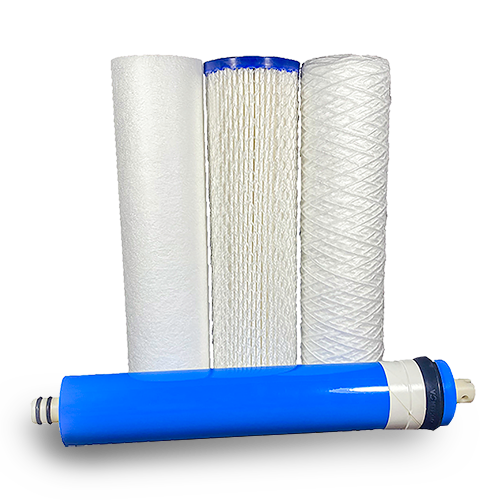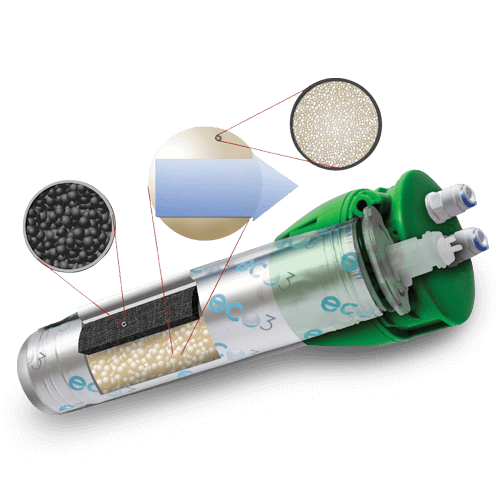Water Treatment
Due to the water quality variances with non-municipal water sources, e.g. borehole water, between geographical areas, we have divided the section in municipal and non-municipal water treatment technology.
Due to the water quality variances with non-municipal water sources, e.g. borehole water, between geographical areas, we have divided the section in municipal and non-municipal water treatment technology.
Water filters for municipal water use two different techniques to remove impurities.
The first is physical or barrier filtration means straining water to remove larger impurities. In other words, a physical filter can be compared to a sieve.
The second technique is activated carbon treatment in either carbon block format or granular activated carbon (GAC).
The third technique is chemical filtration, where water is passed through an active material that removes impurities chemically by way of, for example, Redox reaction media as it passes through. Redox media and carbon treatment are usually used in conjunction with each other.
This is the basis for conventional filtration and refers to a media that’s used as a barrier to filter water through. The micron filtration of this media will determine what is caught within the barrier when the water is passed through it.

All filtration above 0.1 micron, where 1 micron is equal to a millionth of a metre or a thousandth of a millimetre.
The smallest particle visible to the human eye is 40 microns and about 1 to 10 microns in length and from 0.2 to 1 micron in width.
A hollow fibre membrane type system that removes small colloids and large molecules from solutions.
Ultrafiltration removes particles in size range between 0.002 to 0.1 micron range. Viruses are 0.004 to 0.1 microns in size, which is about 100 times smaller than bacteria.
A membrane process that treats water between reverse osmosis and ultrafiltration the filtration/separation spectrum, but we currently do not specialise in this technology.
Alternative approaches will be the use of Reverse Osmosis and Redox Reaction media.
It is a process for the removal of dissolved ions from water, in which pressure is used to force the water through a semi-permeable membrane, which will transmit the water but reject most other suspended and dissolved materials.
It is called reverse osmosis because mechanical pressure is used to force the water to flow in the direction that is the reverse of natural osmosis, namely from the dilute to the concentrated solution.

Coconut shell activated carbon is designed for the reduction of undesirable tastes and odours present in many chlorinated water supplies. Activated carbon also reduce dissolved organic chemicals from municipal and industrial water supplies.
The process to remove contaminants from water using activated carbon is called adsorption (not to be confused with absorption). To obtain maximum efficiency of the activated carbon in the adsorption process, it is desirable to have the greatest possible surface area in the smallest practical volume. This is necessary because the rate of adsorption is proportional to the amount of surface area of the adsorbing media.
When carbon adsorbs contaminants like chlorine, the molecules, ions or atoms from the chlorine collect like a film, called adsorbate, on the carbon. There is only so much space for the adsorbate to collect on the carbon and once saturated, the carbon is no longer effectively and may even release certain pollutants in favour of other ones.
Redox is short for oxidation-reduction, which is a chemical reaction where electrons are transferred between molecules. In some cases, such as free chlorine, this transfer results in the formation of benign substances, such as chloride in this case, which then passes through the filter. In a similar way, copper, lead, mercury, and other heavy metals react to plate out onto the medium’s surface effectively being removed from the water supply. This media is so effective in significantly removing inorganic water-soluble heavy metals.
Active ceramics contains a mixture of elements such as Platinum, Silver and Copper. When the ceramic spheres rub together, these elements create a redox reaction thereby inhibiting the growth of bacteria. KDF55 uses Copper and Zinc to create the same reaction, but because the elements used by active ceramics are further apart on the periodic table, the redox reaction for active ceramics is known to be up to 20 times stronger than using Copper and Zinc.
Please also see our MEDIA COMPARISON CHART for more information.
Borehole water quality varies significantly between geographical areas and can also change over time due to, for example, drought conditions.
The quality of river and dam water can significantly change as a result of a single event, such as chemical spill or biological contamination, e.g. a dead animal. As a result, a water treatment system designed for river or dam water may not be able to deal with a single pollution event of an unknown nature.
There is an overwhelming magnitude of constituents that affect the quality and characteristics of non-municipal water, but in essence can be summarized by the following key constituents, and basic treatment thereof.
The pH in water plays a vital role in the outcome of desired results and its application. pH can be measured between 0 and 14, and ranges from acidic to alkaline. pH imbalance in turn have a direct effect on corrosiveness, scaling and toxicity.
pH can be addressed in a number of ways, from a simple domestic application of using selected pH correct media, to automated pH dosing systems for industrial processes.
Hardness in water is caused by elevated levels of dissolved minerals and in particular calcium and magnesium. Although it does not pose a health risk (at most common levels), it is regarded as problematic for appliances and reticulation networks.
Hard water will cause scale buildup in geyser elements, boilers and reticulation systems. Clogging of pipes and elements will affect incoming pressure supply and cause an increase energy costs and efficiency.
Hardness can be treated in a number of applications such as polyphosphate media, ion exchanging systems, e.g. water softeners and chemical dosing applications.
TDS is made up of a vast array of dissolved mineral substances in water. Elevated TDS levels are usually objectionable to the end consumer, causing excessive scaling on appliances and reticulation systems. It is further unpleasant on the palate and usually resonates with “brackishness”.
The only effective treatment to remove moderate to high TDS levels is through Reverse Osmosis (RO) technology. However, this treatment method is notorious for its high water wastage, and one can expect to lose a considerable amount of water due to this process.
Metallic elements are widely found in groundwater. Elements such as Iron (Fe) and Manganese (Mn), at various concentration levels, are fairly common in the Garden Route area. Metals can have a severe effect on the general colour, taste and odour of water and can cause staining. Iron will cause reddish-brown staining of laundry and can cause deposit buildup in reticulation systems.
These deposit buildups can increase energy costs due to coating of elements and affect water supply and pressure. Manganese leaves traces of brownish-black stains.
Treatment can vary from aeration or oxidation for moderate levels, to specialist iron and manganese removal filter media.
This is a very common form of contamination found in all non-municipal water sources and bears particular relevance to potable applications or industrial food processing. Microbial contaminants include pathogens like bacteria, viruses and parasites. These living organisms can be spread by human and animal wastes accordingly. Key constituents to look for is E.Coli, Total Coliforms, Feacal Coliforms and Total Plate Count.
Bacterial contamination can be addressed in a number of ways during pre-filtration water treatment steps. Most popular methods include chlorination, hollow fibre membrane technology, ozonation, reverse osmosis and ultraviolet sterilisation.
Find a branch near you
Ready to discuss your purifying needs?
Submit your details and one of our specialists will get back to you.